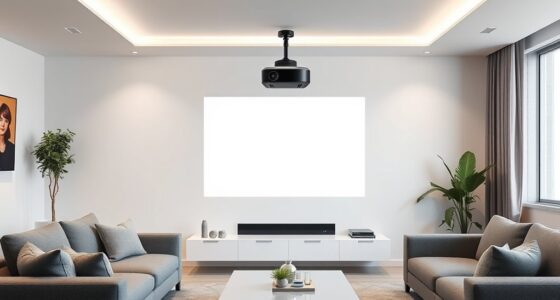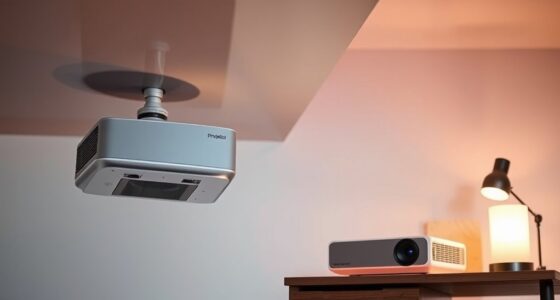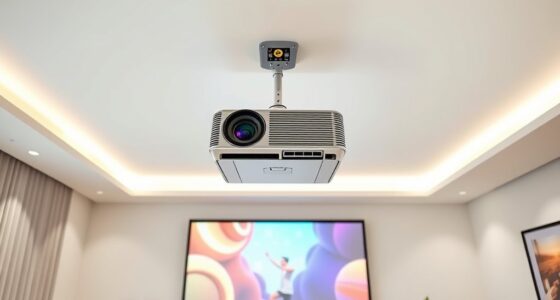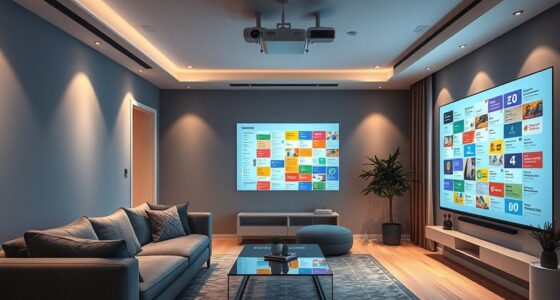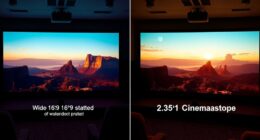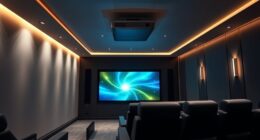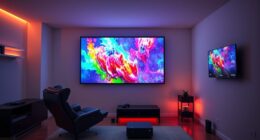Choosing between short throw and long throw projectors depends on your space. If you have a small room or limited area, a short throw projector is ideal, as it can project large images from just inches away. For bigger rooms or outdoor setups with plenty of space, a long throw projector works better, offering larger images from a distance. To discover which suits your space best and get tips on setup, keep exploring the differences.
Key Takeaways
- Short throw projectors are ideal for small spaces, projecting large images from inches away, while long throw models suit larger areas needing more distance.
- Choose a short throw projector for tight rooms or limited outdoor space; opt for a long throw for spacious home theaters or outdoor venues.
- Short throw models reduce shadows and glare, creating a cleaner setup in confined areas; long throw projectors support bigger screens from afar.
- Installation of short throw projectors is easier in limited spaces, whereas long throw models require more room and precise positioning.
- The best choice depends on your room size, available space, and whether you need a portable setup or a large, distant projection.
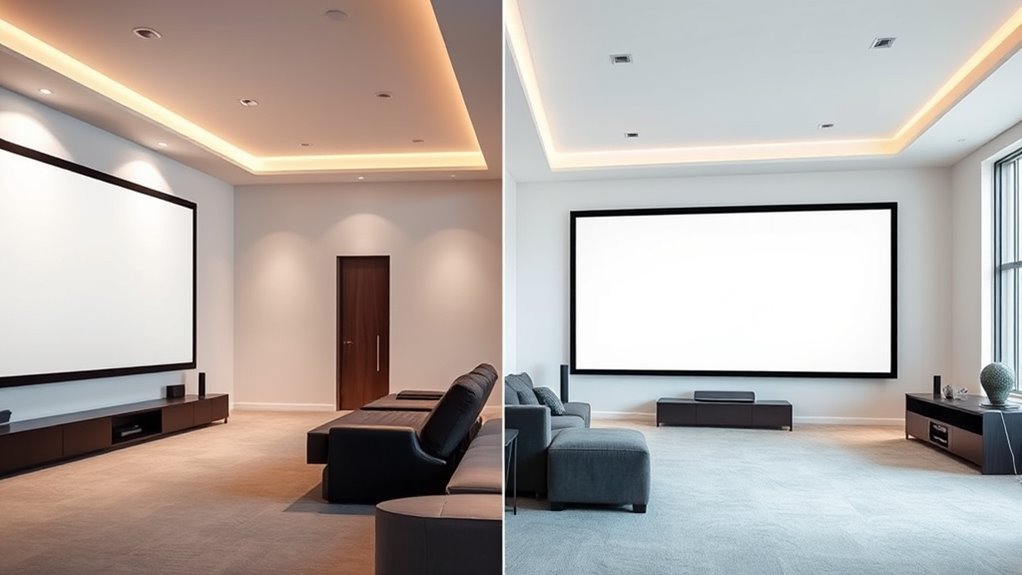
When choosing a projector for your space, understanding the difference between short throw and long throw models is essential. This knowledge helps you pick the right projector for your specific needs, whether you’re setting up a home theater or planning outdoor projection. Short throw projectors are designed to produce large images from a very short distance, making them ideal for tight spaces like small media rooms or dens. If you want a cinematic experience at home without sacrificing space or dealing with complicated installation, a short throw model allows you to place the projector just inches from the wall or screen. This minimizes shadows and glare, creating a clean, clutter-free setup that enhances your viewing experience. Short throw projectors also work well for outdoor projection, especially when space is limited. You can set one up close to a wall or screen in your backyard, and it will still project a clear, sizable image suitable for outdoor movie nights. Their compact design means you don’t need a dedicated projection room; just a flat surface and a bit of open space are enough. Additionally, understanding the projection distance requirements is crucial for optimal setup and image quality.
On the other hand, long throw projectors are better suited for larger spaces or venues where distance isn’t an issue. If you have a spacious home theater or a large outdoor area and want to project onto a big screen from across the room or yard, a long throw model is your best option. These projectors require a significant distance from the screen—sometimes 10 feet or more—to produce a large, high-resolution image. They’re often more powerful and capable of delivering brighter images, which is vital for outdoor projection during daylight hours or in well-lit rooms. Long throw projectors give you flexibility in placement; you can position them far from the screen, reducing the risk of shadows cast by people or objects, which is especially useful when hosting outdoor movie nights with friends and family.
Ultimately, your choice depends on your space constraints and how you plan to use the projector. For a compact home theater setup or outdoor projection in tight spaces, a short throw projector offers convenience and ease of setup. If you have a large room or yard and want to project bigger images from a distance, a long throw projector provides the size and brightness you need. Knowing your space and viewing needs will guide you to the right model, ensuring your investment enhances your entertainment experience, whether indoors or out.
Frequently Asked Questions
Which Projector Type Has Better Image Quality in Bright Rooms?
In bright rooms, a short throw projector typically offers better image quality because it minimizes ambient lighting issues. Since it’s positioned close to the screen, it reduces screen glare and maintains clearer, brighter images even with ambient light present. Long throw projectors may struggle with glare and washed-out images in well-lit spaces. So, if your room has a lot of ambient lighting, a short throw projector is usually the better choice for sharp visuals.
How Do Maintenance Costs Differ Between Short and Long Throw Projectors?
You’ll find that maintenance costs differ between short and long throw projectors mainly due to installation costs and replacement parts. Short throw models typically have higher installation costs because they require precise placement, but replacement parts tend to last longer with less wear on bulbs and filters. Long throw projectors usually have lower installation costs but may need more frequent replacements, increasing overall maintenance expenses over time.
Are Short Throw Projectors Suitable for Outdoor Use?
Short throw projectors can be suitable for outdoor use if they boast bold weather resistance and outdoor durability. You’ll want to look for projectors with rugged weather resistance, shielding them from moisture, dust, and temperature swings. While they’re generally designed for indoor environments, some models are built tough enough for outdoor settings, making them perfect for backyard movies or outdoor events when weather-resistant features are present.
What Are the Power Consumption Differences Between the Two Types?
You’ll find short throw projectors generally more energy-efficient, leading to lower power costs, because they often operate at lower wattages due to their smaller lamp sizes. Long throw projectors tend to consume more energy, which increases your energy bills over time. If saving on power costs matters, a short throw projector can be a smarter choice, especially in spaces where energy efficiency is a priority.
Can Both Projector Types Be Used for Gaming Purposes Effectively?
They say “practice makes perfect,” and that’s true for gaming with projectors too. Both short throw and long throw projectors can be effective for gaming, offering good compatibility and immersive experiences. Short throw projectors excel with setup flexibility in tight spaces, while long throw models work well in larger rooms. Choose based on your space, and you’ll enjoy smooth gameplay and stunning visuals regardless of the type.
Conclusion
Now that you’ve weighed the pros and cons, picture yourself in your perfect space—whether it’s cozy or grand. A short throw projector can create a sharp, vivid display inches from the wall, like a magic trick right before your eyes. Or, if you prefer a sprawling cinematic experience, a long throw projector can fill your entire wall with vibrant images, like a movie theater come to life. Choose what fits your space, and let your imagination run wild.


